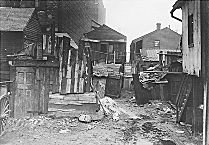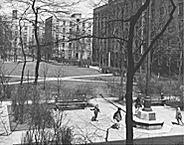| Entries |
| T |
|
Tenements
|

|
After the 1871 fire, the prohibition of wooden frame buildings in the city's core encouraged construction at the outskirts to house the flood of working-class newcomers. The result was a wide belt of small dwellings stretching from the Old Town area on the North Side through the Near West Side to the stockyards, Bridgeport, and the Black Belt south of the Loop. A second stage of tenement evolution occurred with the arrival of immigrants from Southern and Eastern Europe between 1880 and 1914. Desperately poor families, clustering near work sites and people who shared their religious and ethnic backgrounds, fostered subdivision of already crowded dwellings and construction of cheap “ rear houses. ”
Fear of epidemics and the specter of “New York conditions” fed Chicago's movement for tenement reform. After 1880, the city's health department had authority to inspect and to approve construction plans for tenements and workshops, but population growth and the proliferation of tenements overwhelmed official monitoring. Beginning in the 1890s, settlement house workers and scholars focused public attention on certain districts within the sprawling belt of worker housing. Hull-House Maps and Papers (1895), Robert Hunter's Tenement Conditions in Chicago (1901), and Edith Abbott and Sophonisba Breckinridge's The Tenements of Chicago, 1908–1935 (1936) reviewed housing conditions and the mixed results of reform.

|
The Encyclopedia of Chicago © 2004 The Newberry Library. All Rights Reserved. Portions are copyrighted by other institutions and individuals. Additional information on copyright and permissions.